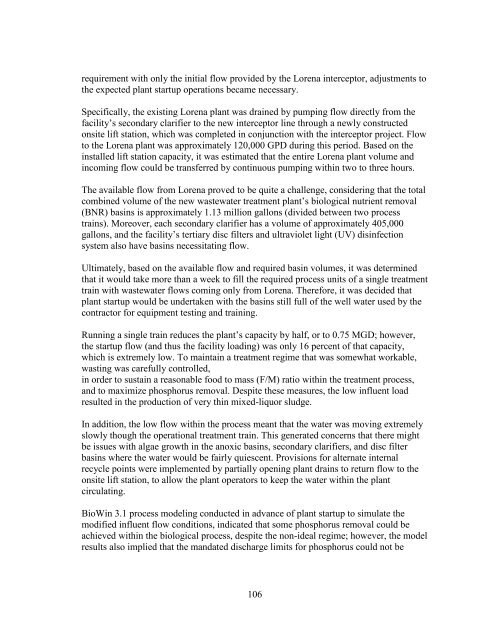PERCEIVED RISK AND THE SITING OF A CONTROVERSIAL ...
PERCEIVED RISK AND THE SITING OF A CONTROVERSIAL ...
PERCEIVED RISK AND THE SITING OF A CONTROVERSIAL ...
Create successful ePaper yourself
Turn your PDF publications into a flip-book with our unique Google optimized e-Paper software.
equirement with only the initial flow provided by the Lorena interceptor, adjustments to<br />
the expected plant startup operations became necessary.<br />
Specifically, the existing Lorena plant was drained by pumping flow directly from the<br />
facility’s secondary clarifier to the new interceptor line through a newly constructed<br />
onsite lift station, which was completed in conjunction with the interceptor project. Flow<br />
to the Lorena plant was approximately 120,000 GPD during this period. Based on the<br />
installed lift station capacity, it was estimated that the entire Lorena plant volume and<br />
incoming flow could be transferred by continuous pumping within two to three hours.<br />
The available flow from Lorena proved to be quite a challenge, considering that the total<br />
combined volume of the new wastewater treatment plant’s biological nutrient removal<br />
(BNR) basins is approximately 1.13 million gallons (divided between two process<br />
trains). Moreover, each secondary clarifier has a volume of approximately 405,000<br />
gallons, and the facility’s tertiary disc filters and ultraviolet light (UV) disinfection<br />
system also have basins necessitating flow.<br />
Ultimately, based on the available flow and required basin volumes, it was determined<br />
that it would take more than a week to fill the required process units of a single treatment<br />
train with wastewater flows coming only from Lorena. Therefore, it was decided that<br />
plant startup would be undertaken with the basins still full of the well water used by the<br />
contractor for equipment testing and training.<br />
Running a single train reduces the plant’s capacity by half, or to 0.75 MGD; however,<br />
the startup flow (and thus the facility loading) was only 16 percent of that capacity,<br />
which is extremely low. To maintain a treatment regime that was somewhat workable,<br />
wasting was carefully controlled,<br />
in order to sustain a reasonable food to mass (F/M) ratio within the treatment process,<br />
and to maximize phosphorus removal. Despite these measures, the low influent load<br />
resulted in the production of very thin mixed-liquor sludge.<br />
In addition, the low flow within the process meant that the water was moving extremely<br />
slowly though the operational treatment train. This generated concerns that there might<br />
be issues with algae growth in the anoxic basins, secondary clarifiers, and disc filter<br />
basins where the water would be fairly quiescent. Provisions for alternate internal<br />
recycle points were implemented by partially opening plant drains to return flow to the<br />
onsite lift station, to allow the plant operators to keep the water within the plant<br />
circulating.<br />
BioWin 3.1 process modeling conducted in advance of plant startup to simulate the<br />
modified influent flow conditions, indicated that some phosphorus removal could be<br />
achieved within the biological process, despite the non-ideal regime; however, the model<br />
results also implied that the mandated discharge limits for phosphorus could not be<br />
106
















